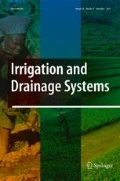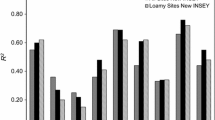Abstract
Components of a satellite-based system for estimating the crop water requirements of irrigated vegetation have been combined, applied, and tested against field data in the Yaqui Valley, northwest Mexico. Frequent satellite observations have the potential to provide snap shots of cloud variability at the high spatial and temporal resolutions that are needed for making simple, near real-time estimates of incoming solar radiation and, thus, daytime evaporation required for irrigation scheduling. Less frequent polar orbiting satellites offer the capacity of following the vegetation development at higher spatial resolution. The operational framework for obtaining cloud cover has been developed and applied using hourly sampled, 1 km resolution, GOES-10 data received in real-time. The high-resolution, cloud-screening algorithm has proved to be efficient and reliable and has been used to provide high-resolution (4 km) estimates of solar radiation.
Relationships between vegetation indices (NDVI and SAVI) and crop coefficients (the ratio of measured to reference evapotranspiration) have been derived with four different models (Shuttleworth, Penman, Priestley–Taylor and Makkink), using ground-based surface reflectance measured over the crop. Continuous measurements of surface fluxes and other meteorological variables were made following almost the entire vegetative cycle of the plant using a station equipped with standard meteorological instruments and an eddy-correlation system. Actual evapotranspiration was computed as the product of the estimated crop coefficients, derived from field radiometer measurements, and reference evapotranspiration. In comparison with ground data, RMSE values are on the order of 1 mm per day.
Finally the opportunity to use high-resolution satellite data to make near real-time estimates of crop evaporation is discussed.
Résumé
Composants d'un système basé en satellite pour estimer les exigences d'eau d'irrigation de la végétation ont été regroupés, appliqués, et testés contre les données du champ dans la Vallée Yaqui, nord-ouest de Mexique. Fréquentement les observations par satellite ont le potentiel de fournir les photos instantanées de variabilité du nuage à hautes résolutions spatiales et résolutions temporelles que sont nécessaire pour faire estimations simple et de temps réels, de la radiation solaire qui entre et, donc, l'évaporation de la journée a exigée pour planification de l'irrigation. Moins fréquent les gravitant satellites polaires offrent la capacité de suivre le développement de la végétation à plus haute résolution spatiale. La structure opérationnelle pour obtenir le plafond de nuages a été développée et appliquée utilisant des donnés de toutes les heures, á 1 km de résolution, GOES-10 données comme reçu dans le vrai temps., l'algorithme de discrimination de nuage d'haute résolution a prouvé pour être effectif et fiable et a été utilisé pour fournir la haute résolution (4 km) évaluations de radiation solaire.
Rapports entre index de la végétation (NDVI et SAVI) et coefficient de la récolte (la proportion de mesuré à evapotranspiration potentiel) avec quatre modèles différents (Shuttleworth, Penman, Priestley-Taylor and Makkink) a été dérivé, utiliser fondez reflectance de la surface basé mesuré sur la récolte. Continu mesurés de flux de la surface et autres variables météorologiques suivre presque le cycle végétatif entier de la plante qui utilise un poste équipée avec les instruments météorologiques standards et un système de la remous – corrélation. L'evapotranspiration réel a été calculé comme le produit des coefficients de la récolte estimés, dérivé de dimensions du radiomètre du champ, et evapotranspiration potentiel. En comparaison avec l'information du terre, RMSE les valeurs ont été sur l'ordre de 1 mm par jour.
Finalement l'occasion d'utiliser le données du satellite de haute résolution de faire près évaluations de vrai temps d'évaporation de la récolte est discutée.
Similar content being viewed by others
References
Allen, R.G., Pereira, L., Raes, D. & Smith, M. 1998. Crop evapotranspiration: Guidelines for computing crop water requirements. Irrigation and Drainage Paper No. 56. Food and Agriculture Organization of the United Nations, Rome, 290 pp.
de Bruin, H.A.R. 1987. In: J.C. Hoogart (Ed.). From Penman to Makkink. Evaporation and Weather: Proceedings and Information. 39. TNO Committee on Hydrological Research Technical Meeting, 44. Ede, The Netherlands.
Dedieu, G., Deschamps, Y. & Kerr, Y.H. 1987. Satellite estimation of solar irradiance at the surface of the earth and surface albedo using a physical model applied to metoeosat data. Journal of Applied Meteorology 26: 79–87.
Dedieu, G., Cabot, F. & Chehbouni, G. 2001. Proposition de mission sur micro-satellite. http://www.cesbio.ups-tlse.fr/pdf/rhea2001_update_260401.pdf.
Doorenbos, J. & Pruitt, W.O. 1977. Guidelines for predicting crop water requirements. Irrigation and Drainage Paper 24. Food and Agriculture Organization of the United Nations, Rome, 179 p.
Garatuza-Payan, J., Watts, C.J. & Cervera, L.E. 1992. Estimacion de Evapotranspiracion Potencial en el Valle del Yaqui. (Potential Evapotranspiration Estimates in the Yaqui Valley). XII Congreso de Hidraulica, Puerto Vallarta, Mexico.
Garatuza-Payan, J., Shuttleworth, W.J., Encinas, D., McNeil, D.D., Stewart, J.B., deBruin, H. & Watts, C. 1998. Measurement and modelling evaporation for irrigated crops in Northwest Mexico. Hydrological Processes 12: 1397–1418.
Garatuza-Payan, J., Pinker, R.T. & Shuttleworth, W.J. 2001a. High resolution day-time cloud observations for northwestern Mexico from GOES-7 satellite data. Journal of Atmospheric and Oceanic Technology 105(1): 39–56.
Garatuza-Payan, J., Shuttleworth, W.J. & Pinker, R.T. 2001b. Satellite measurements of solar radiation in the Yaqui Valley, Northern Mexico. Geofísica Internacional 40(3): 207–218.
Garatuza-Payn, J., Pinker, R.T., Shuttleworth, W.J. & Watts, C. 2001c. Solar radiation and evapotranspiration in northern Mexico estimated from remotely sensed measurements of cloudiness. Hydrological Sciences Journal 46(3): 465–478.
Garatuza-Payán, J., Tamayo, A., Watts, C. & Rodríguez, J.C. 2003. Estimating large area wheat evapotranspiration from remote sensing data”, 2003 IEEE International Geoscience and Remote Sensing Symposium I: pp. 380–382
Gautier, C., Georges, D. & Masse, S. 1980. A simple physical model to estimate incident solar radiation at the surface from GOES satellite data. Journal of Applied Meteorology 19: 1005–1012.
Huete, A.R. 1988. A soil adjusted vegetation index (SAVI). Remote Sensing of the Environment 25: 295–309.
Iqbal, M., 1983. An Introduction to Solar Radiation. Academic Press, Canada, p. 390.
Jochum, A.N., Calera, A. & Cuesta, A. 2003. Irrigation Management from Space: Towards User-Defined Products. ICID International Workshop on Use of Remote Sensing of Crop Evapotranspiration for Large Regions, September, 2003, Montpellier, France (to be published).
Makkink, G.F. 1957. Testing the Penman formula by means of lysimiters. Journal of Institute of Water Engineering 11: 277–288.
Monteith, J.L. 1965. Evaporation and Environment. 19th Symposia of the Society for Experimental Biology. University Press, Cambridge, Vol 19: pp. 205–234.
Penman, H.L. 1948. Natural evaporation from open water, bare soil, and grass. Proceedings of the Royal Society of London A193: 120–143.
Pinker, R.T. & Ewing, J.A. 1985. Modeling surface solar radiation: Model formulation and validation. Journal of Climate and Applied Meteorology 24: 389–401.
Pinker, R.T. & Lazlo, I. 1992. Modeling surface solar irradiance for satellite applications on a global scale. Journal of Applied Meteorology 31(2): 194–211.
Pinker, R.T., Frouin, R. & Li, Z. 1995. A review of satellite methods to derive surface shortwave irradiance. Remote Sensing of Environment 51: 105–124.
Priestley, C.H.B. & Taylor, R.J. 1972. On the assessment of surface heat flux and evaporation using large scale parameters. Monthly Weather Review 100: 81–92.
Raphael, C. & Hay, J.E. 1984. An assessment of models which use satellite data to estimate solar irradiance at the Earthapos;s surface. Journal of Climate and Applied Meteorology 23: 832–844.
Rodriguez, J.C., Duchemin, B., Watts, C.J. Hadria, R., Garatuza, J., Chehbouni, A., Boulet, G., Armenta, M., & Er-Raki, S. 2003. Wheat yields estimation using remote sensing and crop modeling in the Yaqui Valley in Mexico”, 2003 IEEE International Geoscience and Remote Sensing Symposium IV: pp. 2221–2223.
Rossow, W.B. & Garder, L.C. 1993a. Cloud detection using satellite measurements of infrared and visible radiances for ISCCP. Journal of Climate 6: 2341–2369.
Stewart, J.B., Watts, C.J., Rodriguez, J.C., De Bruin, H.A.R., van den Berg A.R. & Garatuza-Payan, J. 1999. Use of satellite data to estimate radiation and evaporation for northwest Mexico. Agricultural Water Management 38: 181–193.
Thom, A.S. & Oliver, H.R. 1977. On Penmanapos;s equation for estimating regional evaporation. Quarterly Journal of Royal Meteorological Society 103: 345–357.
Twine, T.E., Kustas, W.P., Norman, J.M., Cook, D.R., Houser, P.R., Meyers, T.P., Prueger, J.H., Starks, P.J. & Wesely, M.L. 2000. Correcting eddy-covariance flux underestimates over grassland. Agricultural and Forest Meteorology 103: 279–300.
Whitlock, C.H., Charlock, T.P., Staylor, W.F., Pinker, R.T., Laszlo, I., Ohmura, A., Gilgen, H., Konzelman, T., DiPasquale, R.C., Moats, C.D., LeCroy, S.R. & Ritchey, N.A. 1995. First global WCRP shortwave surface radiation budget data set. Bulletin of the American Meteorological Society 76(6): 1–18.
Zhou, L., Laszlo, I. & Pinker, R.T. 1996. Development of narrow to broadband transformations for GOES 8. Second International Scientific Conference on the Global Energy and Water Cycle, 17–21 June 1996, Washington, D.C.
Author information
Authors and Affiliations
Corresponding author
Rights and permissions
About this article
Cite this article
Garatuza-Payan, J., Watts, C.J. The use of remote sensing for estimating ET of irrigated wheat and cotton in Northwest Mexico. Irrig Drainage Syst 19, 301–320 (2005). https://doi.org/10.1007/s10795-005-5192-2
Issue Date:
DOI: https://doi.org/10.1007/s10795-005-5192-2




